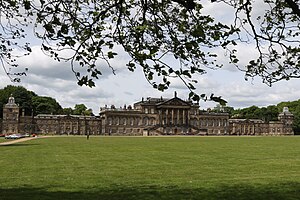Wentworth Woodhouse
| Wentworth Woodhouse | |
|---|---|

East front of Wentworth Woodhouse
|
|
|
Location within South Yorkshire
|
|
| General information | |
| Status | Under construction |
| Type | Stately home |
| Architectural style | West front English Baroque East front Palladian |
| Location | Wentworth, South Yorkshire |
| Country | England |
| Coordinates | 53°28′27″N 1°24′17″W / 53.47417°N 1.40472°W |
| Owner | Wentworth Woodhouse Preservation Trust |
| Design and construction | |
| Architect | William Etty Ralph Tunnicliffe Henry Flitcroft John Carr |
| Other information | |
| Parking | No |
| Website | |
| www |
|
|
Listed Building – Grade I
|
|
| Designated | 29 April 1952 |
| Reference no. | 1132769 |
| Designated | 1 June 1984 |
| Reference no. | 1001163 |
Wentworth Woodhouse is a Grade I listed country house in the village of Wentworth, near Rotherham in South Yorkshire, England. It is the largest private house in the United Kingdom (aside from royal residences like Windsor Castle and Buckingham Palace) and, with an east front of 606 feet (185 m), has the longest country house façade in Europe. The house has more than 300 rooms, although the precise number is unclear, with 250,000 square feet (23,000 m2) of floorspace (124,600 square feet (11,580 m2) of living area). It covers an area of more than 2.5 acres (1.0 ha), and is surrounded by a 180-acre (73 ha) park, and an estate of 15,000 acres (6,100 ha).
The original Jacobean house was rebuilt by Thomas Watson-Wentworth, 1st Marquess of Rockingham (1693–1750), and vastly expanded by his son, the 2nd Marquess, who was twice Prime Minister, and who established Wentworth Woodhouse as a Whig centre of influence. In the 18th century, the house was inherited by the Earls Fitzwilliam who owned it until 1979, when it passed to the heirs of the 8th and 10th Earls, its value having appreciated from the large quantities of coal discovered on the estate.
Wentworth Woodhouse comprises two joined houses, forming west and east fronts. The original house, now the west front, with the garden range facing northwest towards the village, was built of brick with stone details. The east front of unsurpassed length is credibly said to have been built as the result of a rivalry with the Stainborough branch of the Wentworth family, which inherited the Great Strafford's minor title of Baron Raby, but not his estates, which went to Watson, including the notable series of Strafford portraits by Anthony van Dyck and Daniel Mytens, who added Wentworth to his surname. The Stainborough Wentworths, for whom the Strafford earldom was revived, lived at nearby Wentworth Castle, which was purchased in 1708, in a competitive spirit, and strenuously rebuilt in a magnificent manner.
...
Wikipedia

